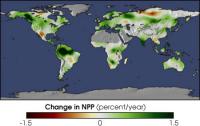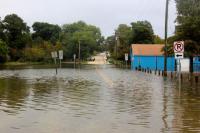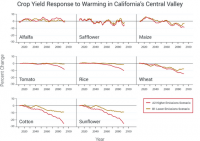-
Climate-driven water scarcity could reduce economic growth by up to 6%: World Bank
Water scarcity, exacerbated by climate change, could cost some regions up to 6 percent of their GDP, spur migration, and spark conflict, according to a new World Bank report released the other day. The report says the combined effects of growing populations, rising incomes, and expanding cities will see demand for water rising exponentially, while supply becomes more erratic and uncertain.
-
-
Climate-exodus expected as temperatures rise in Middle East, North Africa
More than 500 million people live in the Middle East and North Africa — a region which is very hot in summer and where climate change is already evident. The temperature during summer in the already very hot Middle East and North Africa will increase more than two times faster compared to the average global warming. This means that during hot days temperatures south of the Mediterranean will reach around 46 degrees Celsius (approximately 114 degrees Fahrenheit) by mid-century. As a result, the number of climate refugees could increase dramatically in future.
-
-
A rising tide of migration
“With sea levels on the rise, several island nations are scrambling to stay above water and ensure citizens will have a place to go when the ocean engulfs their homeland. The humanitarian-crisis phase of climate change has officially begun” – these are the opening sentences of an article just published in the Columbia Law School Magazine.
-
-
CO2 fertilization is greening the Earth

A new, comprehensive study shows a significant greening of a quarter to one-half of the Earth’s vegetated lands. The greening represents an increase in leaves on plants and trees. Green leaves produce sugars using energy in the sunlight to mix carbon dioxide (CO2) drawn in from the air with water and nutrients pumped in from the ground.
-
-
Putting consistent value on experts' uncertainty on climate change models
Science can flourish when experts disagree, but in the governmental realm uncertainty can lead to inadequate policy and preparedness. When it comes to climate change, it can be OK for computational models to differ on what future sea levels will be. The same flexibility does not exist for determining the height of a seawall needed to protect people from devastating floods. For the first time in the climate field, researchers have combined two techniques long used in fields where uncertainty is coupled with a crucial need for accurate risk-assessment — such as nuclear energy — in order to bridge the gap between projections of Earth’s future climate and the need to prepare for it.
-
-
Rising seas put Vietnam in the “bull’s eye” of rising seas

A rising sea level — for a country like Vietnam, with 2,000 miles of coastline — presents a major environmental and food security challenge, especially in the Mekong River Delta region where 22 percent of the population lives and about half of the country’s food is produced.
-
-
“G-Science” academies call for strengthening global disaster resilience

In the decade between 2005 and 2014, more than 6,000 natural and technological disasters occurred around the world, killing more than 0.8 million people, displacing millions more, and costing more than $1 trillion. Losses due to disasters are increasing in both developed and developing countries. Human factors that increase exposure and vulnerability, such as poverty, rapid population growth, disorderly urbanization, corruption, conflict and changes in land use, poor infrastructure including non-engineered housing, together with effects of climate change on weather patterns with increased extreme events, aggravate the negative consequences of natural and technological hazards.
-
-
A single oil field a key culprit in global ethane gas increase
A single U.S. shale oil field is responsible for much of the past decade’s increase in global atmospheric levels of ethane, a gas that can damage air quality and impact climate, according to a new study. The researchers found that the Bakken Formation, an oil and gas field in North Dakota and Montana, is emitting roughly 2 percent of the globe’s ethane. This is about 250,000 tons per year.
-
-
New Web portal for coastal resilience

William & Mary Law School and William & Mary’s Virginia Institute of Marine Science (VIMS) are collaborating on a new Web site which will provide key information to support local, regional, and state efforts to adapt to sea-level rise. Tidal and storm surge flooding risks, FEMA flood zone maps, storm history, and critical infrastructure risk assessments are all topics that are likely to be included on the Web site. Information about conditions of shorelines, wetlands, beaches, and coastal forests will also be in the portal.
-
-
Changing climate in Michigan poses an emerging public health threat

Changing climate conditions — including warmer temperatures and an increased frequency of heavy rainstorms — represent “an emerging threat to public health in Michigan,” according to a new report from University of Michigan researchers and state health officials.
-
-
1.5°C vs 2°C global warming: Half a degree makes a big difference

European researchers have found substantially different climate change impacts for a global warming of 1.5°C and 2°C by 2100, the two temperature limits included in the Paris climate agreement. The additional 0.5°C would mean a 10-cm-higher global sea-level rise by 2100, longer heat waves, and would result in virtually all tropical coral reefs being at risk.
-
-
Global warming could help crops’ productivity

Many scientists fear that global warming will hit staple food crops hard, with heat stress, extreme weather events, and water shortages. On the other hand, higher levels of carbon dioxide — the main cause of ongoing warming — is known to boost many plants’ productivity, and reduce their use of water. So, if we keep pouring more CO2 into the air, will crops fail, or benefit? A new study tries to disentangle this complex question. It suggests that while greater warmth will reduce yields of some crops, higher CO2 could help mitigate the effects in some regions, unless other complications of global warming interfere.
-
-
Globe continues to break heat records -- for 11th straight month
At the risk of sounding like a broken record, March set another heat record for the globe. As Earth continues to warm, and is influenced by phenomena such as El Niño, global temperature records are piling up. For 2016 year to date (January-March), the average temperature for the globe was 2.07 degrees F above the twentieth-century average. This was the highest temperature for this period in the 1880–2016 record.
-
-
Fossil fuels could be phased out worldwide in a decade: Study
The worldwide reliance on burning fossil fuels to create energy could be phased out in a decade, according to energy experts. The experts analyzed energy transitions throughout history, and argue that only looking toward the past can often paint an overly bleak and unnecessary picture. The transition from wood to coal in Europe, for example, took between 96 and 160 years, whereas electricity took 47 to 69 years to enter into mainstream use. The future could be different: the scarcity of resources, the threat of climate change, and vastly improved technological learning and innovation could greatly accelerate a global shift to a cleaner energy future.
-
-
Underestimate global warming by exaggerating cloud “brightening”
As the atmosphere warms, clouds become increasingly composed of liquid rather than ice, making them brighter. Because liquid clouds reflect more sunlight back to space than ice clouds, this “cloud phase feedback” acts as a brake on global warming in climate models. Researchers at Lawrence Livermore National Laboratory and Yale University have found, however, that climate models are aggressively making clouds “brighter” as the planet warms. This may be causing models to underestimate how much global warming will occur due to increasing carbon dioxide.
-
- All
- Regional
- Water
- Biometrics
- Borders/Immig
- Business
- Cybersecurity
- Detection
- Disasters
- Government
- Infrastructure
- International
- Public health
- Public Safety
- Communication interoperabillity
- Emergency services
- Emergency medical services
- Fire
- First response
- IEDs
- Law Enforcement
- Law Enforcement Technology
- Military technology
- Nonlethal weapons
- Nuclear weapons
- Personal protection equipment
- Police
- Notification /alert systems
- Situational awareness
- Weapons systems
- Sci-Tech
- Sector Reports
- Surveillance
- Transportation
Advertising & Marketing: advertise@newswirepubs.com
Editorial: editor@newswirepubs.com
General: info@newswirepubs.com
2010-2011 © News Wire Publications, LLC News Wire Publications, LLC
220 Old Country Road | Suite 200 | Mineola | New York | 11501
Permissions and Policies
Editorial: editor@newswirepubs.com
General: info@newswirepubs.com
2010-2011 © News Wire Publications, LLC News Wire Publications, LLC
220 Old Country Road | Suite 200 | Mineola | New York | 11501
Permissions and Policies
